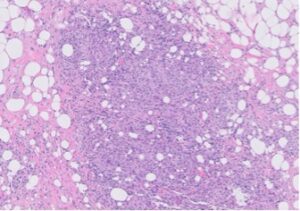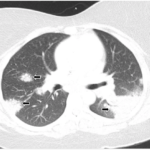The terrorist attacks on the Twin Towers at the World Trade Center (WTC) that led to their destruction on Sept. 11, 2001, as well as the subsequent year-long cleanup of the site (i.e., Ground Zero) in 2001 and 2002, not only had immediate implications for the lives and health of thousands of individuals at the site, but also caused long-term health effects that continue to be seen in a select group of patients.
We report a case of peritoneal granulomatous disease in a patient thought to have sarcoidosis for over a decade, but which is now believed to be secondary to foreign body exposure from Ground Zero.
The Case
A 50-year-old man who had volunteered at Ground Zero for four months in 2001 presented with abdominal pain in 2022.
He initially developed diffuse, continuous abdominal pain in 2007. Associated symptoms included productive cough with clear sputum and nasal congestion. At that time, laboratory tests were significant for an elevated platelet count of 557×103/μL (reference range [RR]: 150–400×103/μL) and a white blood cell count (WBC) of 11.7×10 3/μL (RR: 4.5–11×103/μL), with neutrophilic predominance. Further testing showed a urine analysis, a basic metabolic panel and creatine kinase were all within normal limits. Testing for infectious causes of his symptoms, including a tuberculosis skin test and blood cultures, was unrevealing.
An X-ray of his chest was unremarkable, but a computed tomography (CT) scan of the abdomen revealed diffuse mesenteric nodules in the peritoneum. An exploratory laparotomy revealed punched-out, noncaseating granulomas, with evidence of focal necrosis, concerning for sarcoidosis or Q fever (Coxiella burnetii infection).
A multi-disciplinary review received from other hospitals concluded the patient likely had either sarcoidosis or Q fever. Kveim testing was negative. The patient was not started on any treatment and was lost to follow-up.
In the following years, the patient continued to experience intermittent episodes of abdominal pain. He did not seek medical care during this time, in part due to frustration with the inability of physicians to offer him a firm diagnosis.
In 2022, he presented to the emergency department with intractable, diffuse abdominal pain, fevers to 102ºF and diaphoresis. He also reported chronic diarrhea and intermittent blurry vision.

FIGURE 1A: Loose granuloma/swirling histiocytes and admixed acute inflammation can be seen in mesenteric fat. (Click to enlarge.)
A rheumatologist ordered laboratory tests for anti-nuclear antibody (ANA), rheumatoid factor, anti-CCP antibody, SSA/SSB, anti-neutrophil cytoplasmic antibodies (ANCA), myeloperoxidase (MPO) and proteinase (PR3), all of which were normal. Evaluation for HIV, tuberculosis, Strongyloides and Q fever was negative.


